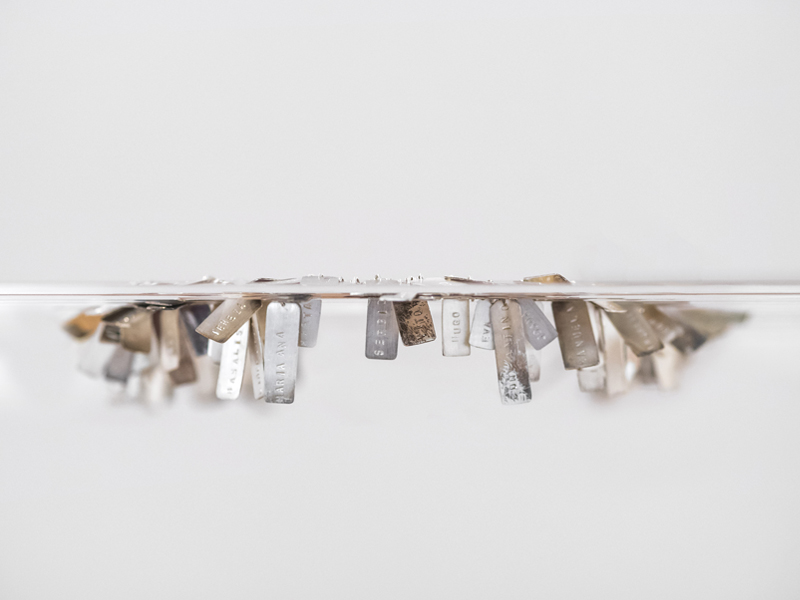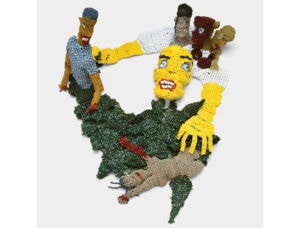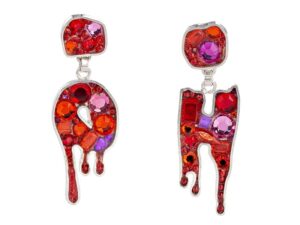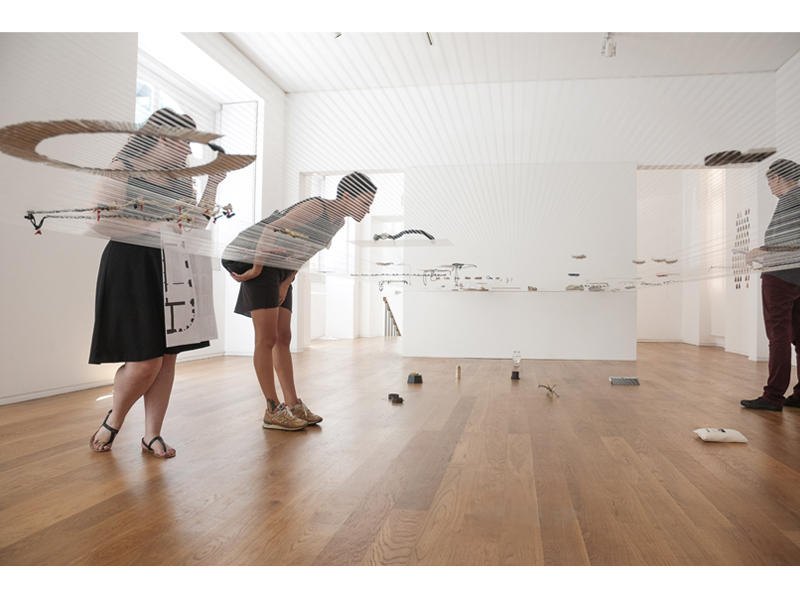
When working on Shows and Tales—On Jewelry Exhibition-Making, AJF’s latest publication, I was well aware that a number of important exhibitions were missing from the book, and that certain exhibition environments—in particular commercial and associative projects—were under-represented in it. With the possibility of a second Shows and Tales volume in mind, I have asked some writers to report on past exhibitions, using the documents at the historian’s disposal: images, curator interviews, exhibition statements. Lizzie Atkins very kindly accepted the challenge: She interviewed both the curator and the organizer, talked to visitors, and studied images of the show in order to bring the project back to life, and make room for it in our ongoing study of the medium of exhibition-making.
—Benjamin Lignel
PIN 10 Anos—PIN 10 Years
September 10–October 3, 2014
Galeria de Arte Moderna Fernando Azevedo, Sociedade Nacional de Belas Artes, Lisbon, Portugal
For three short weeks in 2014, a bold and beautifully executed exhibition turned the spotlight on Portuguese contemporary jewelry from the last decade. The exhibition, PIN 10 Years, was conceived in celebration of the tenth anniversary of PIN (Portuguese Association for Contemporary Jewellery) and presented work created by its members in the years since its inception in 2004. To mount such an ambitious exhibition in such a small community, in a country still nursing the painful scars of austerity following its eurozone bailout, was an audacious undertaking by Cristina Filipe (PIN chairman) and her fellow board members, and a testament to their desire to map the evolution of contemporary jewelry in Portugal and Portuguese contemporary jewelry on the international stage.
Founded by Cristina Filipe, Marília Maria Mira, and Paula Paour, PIN serves as a cultural association that supports and promotes the work of Portuguese and Brazilian artists both at home and abroad, encourages debate and exchange across the arts, and aspires to “conquer new audiences for contemporary jewellery.”[1] Members represent a dynamic group of jewelry artists, curators, teachers, museum directors, and collectors, and although numbers have dwindled, there are currently around 100 active members, including one museum and three Portuguese art schools (ESAD, Ar.Co, and UCP). Its inaugural project was the hosting of the tenth edition of the Ars Ornata Europeana international jewelry symposium, held in Lisbon, and since then it has navigated the ebb and flow of the fortunes of an organization dedicated to a relatively recondite art form operating with the bare minimum of resources.

A team of eight PIN members, including Ana Campos (who produced the show) and Cristina Filipe (responsible for overall coordination), was assembled for the exhibition’s creation and execution. Marie-José van den Hout, founder and director of Galerie Marzee, was brought in to curate the exhibition, and Fernando Brízio, renowned Portuguese designer and head of the design product master’s degree at ESAD, was responsible for its design.
It was important to Filipe and the PIN board that the selection of work for inclusion should be made by an outsider, someone who could assess the jewelry without emotional attachment to any of the artists. And the choice of van den Hout was not incidental. In the 80s, Marzee was the first gallery in Holland to exhibit work by Portuguese jewelry artists, so her understanding of a “Portuguese soul,”[2] along with her wider knowledge and experience, made her the perfect candidate.
Applications were received from 58 current or former members of PIN, presenting van den Hout with the unenviable task of making her selection from over 500 pieces of jewelry. Distance and logistics made it impossible for this to be done in person, so the work was instead chosen from images—an approach that van den Hout found both frustrating and often misleading. Discussing the selection process in an interview with Filipe, she said, “You need to touch, to smell, to see the work … Sometimes artists make fantastic images and in reality it [the work] just isn’t very good. Conversely, some people have very good work, with beautiful details, which you don’t see in the images.”[3]
In the end, 90 pieces by 27 artists made the cut, and together they represented an eclectic collection. Van den Hout was given completely free rein, favoring work that was “more about aesthetics”[4] and consciously deciding not to include conceptual work—work that comments on jewelry—something that she describes as a “dangerous trend.”[5] Filipe admits that she would have liked the exhibition to have been more chronological, showing some of the most emblematic pieces by important artists, but she is pragmatic. Some didn’t apply, others weren’t chosen. As a conceptual jeweler herself, producing work that is self-referential in its critique of jewelry and its rituals, Filipe made a choice of curator that might seem unusually magnanimous. A neutral eye was key, though, and although the exhibition marked PIN’s first decade, it wasn’t conceived as a retrospective. It was more a celebration of the diversity of work produced by its members. As such, van den Hout’s selection offered just one glimpse of the work created by PIN members over its first decade, one possibility among many.
With the selections finalized in April 2014, attention turned to the exhibition display. Following an unsuccessful application for institutional funding, the show was to be produced on a shoestring. All those involved agreed to work for free, and Brízio rose to the challenge of designing a space with a negligible budget, something he described as “turbulent but exciting.”[6] The result was an astonishing technical tour de force.
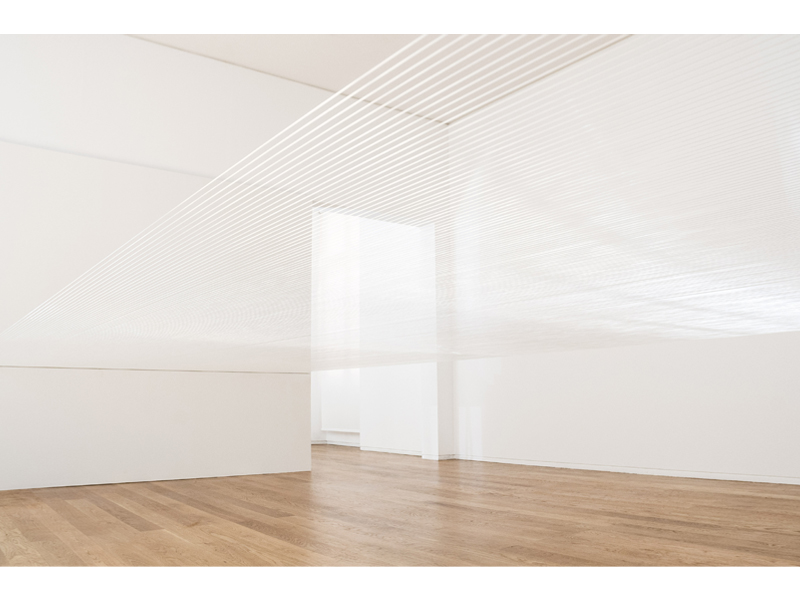
Housed in the Galeria de Arte Moderna Fernando Azevedo, part of the Sociedade Nacional de Belas Artes (National Society of Fine Arts) in Lisbon, the exhibition ran over two floors, making use of the magnificent natural light on the ground floor of the building. Two hundred and fifty nylon threads, one millimeter thick and separated by one-centimeter gaps, were stretched between two wood panels that were fastened to the walls of the gallery. Measuring 8.5 x 2.5 meters, these threads created a vast and, at times, invisible “table” on which the jewelry could be displayed, apparently floating in mid-air, with other pieces resting on the floor beneath. Through the course of the day, the transparency of the nylon altered, depending on the amount of light that entered the space. It seemed sometimes absent, sometimes luminous, always surprising.
To create an exhibition structure with fine, taut, yet flexible threads is, without question, courageous—foolhardy, some might say. Even Brízio had his doubts. But rigorous studio testing of the behavior of his dynamic material clearly demonstrated its suitability. The transparency of the surface meant that each of the pieces could be viewed from multiple angles. Unencumbered by a display case or a wall, they were no longer static “exhibits” but something more motile, the fragility and lightness of the nylon allowing them the space to breathe and to oscillate gently when the wires moved. Brizio’s display device may not have employed the props and gimmicks required of an unlikely and unexpected setting, nor did it play to the showmanship of performative or parading exhibitions, but it was nonetheless an extraordinary, if understated and thoughtful, spectacle. The sense of fragility was essential as it functioned as an apt visual metaphor for PIN’s perpetually precarious existence—always on vulnerable ground but always moving forward.
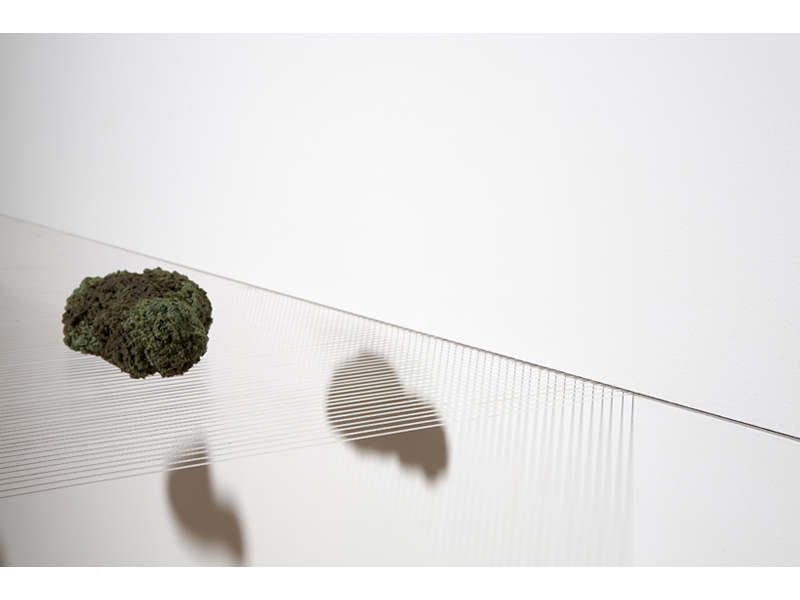
Van den Hout proposed the inclusion of a series of portraits of people wearing some of the exhibited pieces in an effort to make it “come alive” and so, in addition to the display of jewelry, the exhibition also included a photographic narrative of the history of PIN. It was decided that the subjects of the portraits would be some of the people who had supported PIN over the last decade, and Brízio suggested that a different photographer should be commissioned for each portrait (17 in total), thus creating a diverse portfolio of images (and subtly avoiding the delicate job of asking one photographer to make all the images for free). Each participant was free to choose the piece they would wear and to discuss the context of their portrait with the photographer, initiating, it was hoped, a provocative dialogue between photographer, sitter, jewelry, and, by extension, the jeweler. The resulting images were hung in the additional gallery space, separate from the work itself but a clear expression of its wearability.
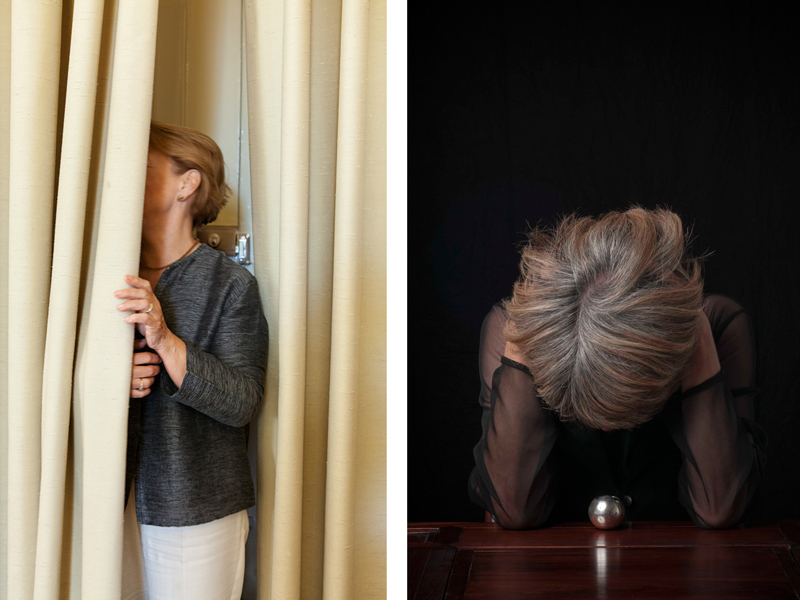
Bearing in mind the financial constraints faced by PIN, it is hardly surprising that no catalog was published to accompany the exhibition. Instead, a large-scale leaflet was produced, detailing the work exhibited along with a floor plan and two related texts—one by Filipe, the other by Ana Campos, whose text offers a more obviously cerebral consideration of the distinctive features of the work. A well-attended program of complementary events, put together by Filipe and the PIN board, included artists talks as well as talks by the curator, and Benjamin Lignel, who presented AJF’s book Contemporary Jewelry in Perspective and gave a workshop entitled Making Exhibitions.
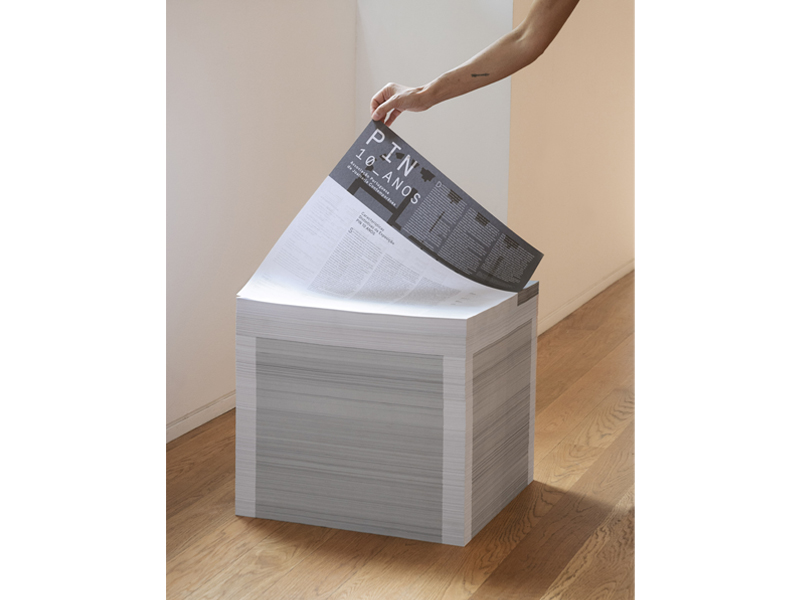
The exhibition was marketed intensively via social media, websites, mailing lists, newspapers, and magazines, and well reviewed in the Portuguese press, but it still garnered the attention of only a relatively small audience—approximately 600 visitors across the three weeks, including the opening night. Whether new audiences were enticed by the portraits created by well-known, contemporary Portuguese photographers, or by their illustrious subjects, is difficult to assess. It was certainly hoped that this would be a consequence of collaborating with artists and others from a wider spectrum.
In terms of form and content, Filipe considered the show to be a great success and it was, unquestionably, exquisitely realized by Brízio, but did it really reach beyond its established, domestic audience? All the work was for sale, albeit timidly. Prices were not shown, and by the end of the exhibition only one ring had been sold, and even then this was to another exhibitor. Sales are not, of course, the be-all and end-all, but let’s not be coy. Sales mean cash and cash means security and opportunity. Without money, important organizations like PIN will not survive. Filipe had grand ambitions for this tenth anniversary project—to encourage greater critical analysis and debate; draw in more visitors, especially those who are new to contemporary jewelry; ring up more sales; and tour the exhibition outside of Portugal—but it came and went in the blink of an eye, a flash of brilliance like a shooting star briefly burning bright across the night sky.
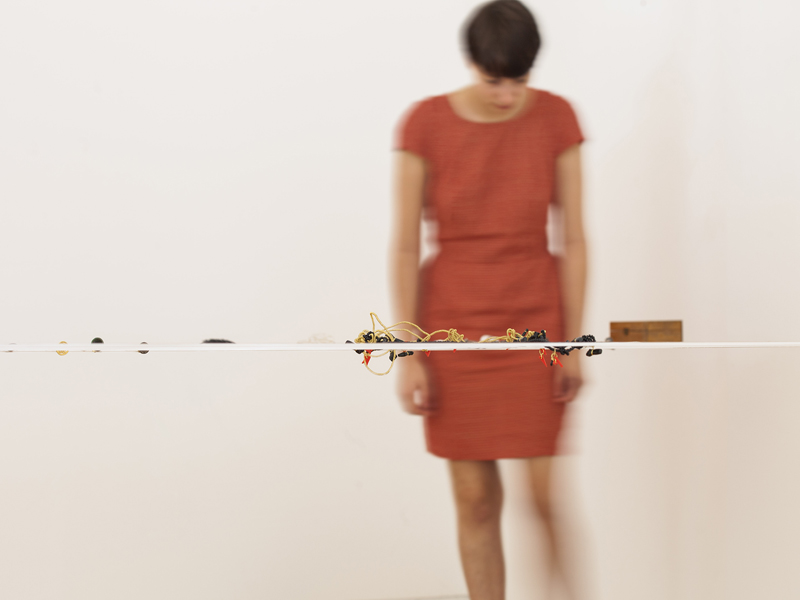
INFORMATION SHEET
Curator: Marie-José van den Hout
Curator assistants: Alexandra Inocêncio and Ana Sousa
General coordinator: Cristina Filipe (PIN)
Producer:Ana Campos (PIN)
Assistants: Beatriz Faustino, Cristina Roque dos Santos, Carlos Silva, Raquel Soares, Inês Sobreira, and Joana Taurino (all PIN).
Scenography and/or exhibition designer: Fernando Brízio, assisted by Nicolaas Leach
Graphic designer: Samuel George (photographic print: Black Box Atelier)
Featured artists (jewelers): Ar.Co (Sónia Brum, Manuela Domingues, Artur Madeira, David Pontes, Alexandra Rodrigues and Carlos Silva), Ana Cardim, Carla Castiajo, Paula Crespo, Teresa Dantas, Estefânia de Almeida, Manuela de Sousa, Patrícia Domingues, Ana Duque, ESAD Matosinhos (Romeu Bettencourt, Arlindo Ferreira, Bianca Henze, Tânia Nunes and Sofia Rocha), Beatriz Faustino, Cristina Filipe, Filomeno, Leonor Hipólito, Hugo Madureira, Margarida Matos, Teresa Milheiro, Marília Maria Mira, Edgar Mosa, Inês Nunes, Renata Porto, Áurea Praga, Tereza Seabra, Carlos Silva, Catarina Silva, Inês Sobreira, and Joana Taurino; (photographers, with sitters given in parentheses) C. B. Aragão (Elsa Garcia and Miguel Matos), Catarina Botelho (Ana Maria Martinho), Laura Castro Caldas (Filomeno), José Pedro Cortes (Theda van Royen), Eurico Lino do Vale (Manuel da Costa Cabral), António Júlio Duarte (Rui Afonso Santos), Helena Gonçalves (Luísa Penalva), José Luís Neto (Teresa Nunes da Ponte), Frederico NS (Manuel Castro Caldas), Carlos Ramos (Paulo Gouveia), Tiago Reis (Graça Amorim), João Paulo Serafim (Teresa Morna), João Silveira Ramos (Tereza Seabra), Eduardo Sousa Ribeiro (Margarida Duarte), Pedro Tropa (José de Guimarães), Mariana Viegas (Paula Crespo), and Valter Vinagre (Madalena Braz Teixeira).
Surface of exhibition: 70.5 square meters (jewelry) and 61.8 square meters (photographs)
Budget: 7,010 euros
Sponsors and funding bodies: Nacional, with the support of Seguradora Hiscox, Black Box Atelier, Hotel Jorge V, Cacilhas Guest House, and HMR
Partner: Sociedade Nacional de Belas Artes
Number of visitors: 600
Related events: artists talks, round-table discussion, and conference with curator Marie-José van den Hout, lecture and workshop on exhibition-making by Benjamin Lignel, exhibition at Reverso gallery
Digital archive:http://www.pin.pt/index.php/pt/projectos-desenvolvidos/2869-pin-10-anos and http://www.pin.pt/index.php/pt/noticias/noticias-2014/2870-inauguracao-exposicao-pin-10-anos.
